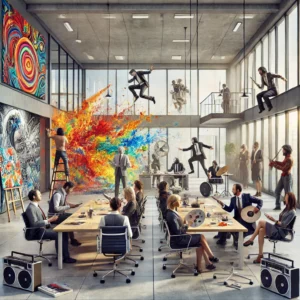The death of systems when creativity thrives
The disruption of art in business and the paralysis of analysis
Introduction
Over the years, I’ve had the privilege of working with many successful business professionals who decided to pursue their passion for music. These individuals bring with them a wealth of experience in efficiency, strategy, and systemization. They’ve thrived in environments where systems are king, where predictability and control are paramount. Yet, when they sit at the piano, they often find themselves frustrated. The structured approaches that serve them so well in business seem to falter in the realm of music.
This isn’t a reflection of their intelligence or effort. It’s about the clash between two fundamentally different paradigms: the systematic world of business and the fluid, unpredictable nature of art. Systems, by their very nature, have flaws—they are rigid and often fail to accommodate the nuances of artistic growth. In music, they tend to break down even sooner, necessitating constant reevaluation and adaptation through feedback between teacher and student.
Business as Usual
In the business world, systems are celebrated. They create efficiency, predictability, and scalability. Michael Gerber’s seminal book, “The E-Myth Revisited,” delves deeply into this mindset. Gerber argues that for a business to be successful, it needs to operate like a well-oiled machine, with every component systematized to function without the constant input of the owner. This approach has revolutionized how many think about business, leading to franchises and scalable models where processes are standardized to the finest detail.
For many professionals, this reliance on systems is second nature. They believe, “Amateurs set goals. Professionals build systems.” In their world, systems provide the boundaries and sequential steps necessary to achieve big goals efficiently. It’s understandable that they—and many others—would attempt to apply the same principles to learning music.
Messy Artistic Growth
Artistic development is rarely tidy. It’s filled with experimentation, mistakes, and unexpected discoveries. The path is often winding, with detours that might seem inefficient from a traditional standpoint but are invaluable for personal growth.
Consider this process:
- Action: Trying something new without a guaranteed outcome.
- Adjustment: Tweaking based on what feels or sounds right.
- Reflection: Listening critically and considering feedback.
- Iteration: Repeating the cycle with new insights each time.
This approach doesn’t fit neatly into a predefined system. It requires patience, openness, and a willingness to embrace uncertainty—qualities that might feel uncomfortable for those accustomed to structured environments.

Real-Life Examples
The Business Blues Enthusiast
I had a student from New Orleans who was also a successful business owner. He wanted to learn blues piano but approached it by creating immaculate, color-coded spreadsheets of blues scales. While his systems were beautifully organized, he wasn’t actually playing any blues. He was analyzing rather than feeling the music.
Eventually, I had to challenge his approach: “Playing blues is something you feel with your body, not analyze with your intellect or business brain. What is your body telling you?” When he opened up to the artistic methods, he began making significant breakthroughs. He realized that living in the blues capital of the world meant there was much to learn from those “annoying jazz musicians.” Now, he’s connected to the mother ship of blues, having embraced the essence of the music beyond spreadsheets.
Physical Limitations
Another student in Florida, battling early-stage MS, couldn’t rely on systems at all due to his physical limitations. He had to listen to his body and sound, giving himself instant feedback and adjusting as he went. Despite the challenges, he’s improved remarkably by embracing flexibility and intuition—key aspects of the artistic process.
The Artistic Process: Embracing Messiness
The process of learning music involves:
- Action: Trying out new pieces or improvisations.
- Modify: Adjusting techniques based on what feels right.
- Feedback: Listening critically to one’s own playing.
- Change: Implementing new ideas or discarding what doesn’t work.
- Discard: Letting go of methods or pieces that don’t resonate.
- Try Again: Continually experimenting and exploring.
This cycle is not linear or predictable. It requires letting go of the need for control and embracing the journey with all its uncertainties.
Music requires immense flexibility. Building intuitions into how you play and practice, with the right questions and re-evaluations, is crucial. You’ll often find you need to change course, sometimes frequently.
The Impermanence of Systems
All systems, by their very nature, eventually break down. In business, market conditions change, technologies evolve, and consumer behaviors shift, rendering once-effective systems obsolete. This necessitates continuous adaptation and reevaluation.
In music, systems break down even sooner. The moment you try to confine music within strict boundaries, it finds a way to spill over. The artistic process is dynamic, responding to emotions, inspirations, and the subtleties of the moment. What worked yesterday might not work today because music is not static; it’s alive and ever-changing.
This impermanence means that constant adjustment and feedback between teacher and student become essential. Without the flexibility to adapt, learners can become stuck, unable to progress beyond the limitations of the system they’re following.
Uber’s Network Effect: A Deeper Reflection of Reality
To bridge the gap between rigid systems and the fluid nature of music, let’s explore Uber’s network effect—a concept that unveils a deeper, more artistic understanding of business success. It’s a sophisticated, modular perspective that mirrors the artistic process in profound ways.
Uber’s success isn’t solely due to a great app or a solid system—many companies can build apps. The real magic lies in the network effect, a positive feedback loop that fuels exponential growth:
- More Drivers Mean Less Waiting Time: As more drivers join the platform, customers experience shorter wait times.
- Less Waiting Time Attracts More Customers: Quick, reliable service brings in more users.
- More Customers Attract More Drivers: Increased demand encourages more drivers to sign up.
- The Loop Continues: Each element amplifies the others, creating a self-sustaining cycle.
This interconnected ecosystem goes beyond traditional systems; it’s dynamic, adaptive, and constantly evolving—a reflection of reality that’s closer to the artistic paradigm than to rigid business models.
Perry Marshall’s Rosetta Stone and the Missing Link
Perry Marshall, a renowned business strategist and author, delves into this concept in his Rosetta Stone course. Marshall explores the network effect and how it serves as a missing link between business and art. He argues that true success often stems from these complex, interconnected systems rather than from linear, step-by-step processes.
In his course, which you can learn more about on Perry Marshall’s website, Marshall presents a holistic approach to understanding business dynamics—one that acknowledges the limitations of traditional systems and embraces the more fluid, adaptive nature of success.
Marshall’s insights reveal that the network effect isn’t just a business phenomenon; it’s a universal principle that applies to various domains, including art. By recognizing this, we can see that the divide between business and art isn’t as wide as it appears. Both realms thrive on interconnectedness, feedback loops, and the ability to adapt to changing circumstances.
The Positive Feedback Loop in Music
Similarly, in music learning, a positive feedback loop accelerates progress by interconnecting various skills and experiences:
- Mastering Chords Enhances Rhythm: As you become more comfortable with chords, your transitions between them improve, strengthening your sense of rhythm and groove.
- Improved Rhythm Boosts Improvisation: A strong rhythmic foundation allows you to explore improvisation more freely and creatively.
- Engaging in Improvisation Deepens Understanding of Chords: Experimenting with improvisation exposes you to new chord combinations and progressions.
- The Cycle Continues: Each skill amplifies the others, creating exponential growth in your musical abilities.
This positive feedback loop mirrors the network effect seen in Uber’s success. It’s not about rigidly following a set of instructions but about engaging with an interconnected system that evolves with you. Just as in Uber’s model, where each component amplifies the others, in music, each skill enhances and is enhanced by the others, creating a self-sustaining cycle of growth.
Embracing the Artistic
The artistic realm requires letting go of the need for control and embracing the unpredictable nature of the creative process. It values adaptability, intuition, and personal expression over strict adherence to a system. In music learning, this means:
- Allowing for Exploration: Giving yourself the freedom to experiment and make mistakes.
- Engaging in Continuous Feedback: Working closely with a teacher or mentor and listening to yourself as a form of feedback.
- Recognising the Limitations of Systems: Understanding that while systems can provide a foundation, they cannot capture the full depth of the artistic experience.
By adopting this mindset, you align yourself with the way art truly operates—dynamic, responsive, and ever-evolving.
The Essential Role of Adaptation and Feedback
Given that systems in music learning inevitably fail and require constant adjustment, adaptation becomes crucial. This is where the relationship between a teacher and student becomes invaluable. Continuous feedback allows for real-time adjustments, ensuring that learning remains responsive and effective.
Consider my student with multiple sclerosis. His physical limitations meant that traditional, systematized methods were not feasible. Instead, we focused on adaptive techniques that prioritized sensory feedback and intuitive playing. Our lessons became a collaborative exploration, constantly adjusting to his needs and discovering new ways to express music.
Similarly, the business owner from New Orleans found liberation when he stepped away from his spreadsheets. By engaging directly with the music—listening, feeling, and experimenting—he tapped into the authentic blues experience that no system could provide.
Conclusion
Systems have their place, providing structure and a starting point. However, in music learning, they quickly reveal their limitations. The artistic paradigm, with its emphasis on adaptability, intuition, and personal expression, offers a more effective and fulfilling path.
By understanding concepts like Uber’s network effect and exploring Perry Marshall’s insights in his Rosetta Stone course, we can see that the divide between business and art is not as vast as it seems. Both require a balance of structure and flexibility, a willingness to adapt, and an appreciation for the interconnectedness of all elements involved.
Embracing this perspective can transform the learning experience. It involves letting go of the need for control, engaging deeply with the process, and recognizing that true progress comes from within the dynamic interplay of skills, experiences, and feedback.
Tom Donald is a pianist, composer, and educator dedicated to helping individuals discover their unique musical voices. He explores the intersections of music, creativity, and personal growth. Connect with him to embark on your own musical journey.
For more on Perry Marshall’s network effect and his innovative approach to bridging business and art, visit Perry Marshall’s website.
If you’d like to find out more about how LCSP coaching can enhance your creative output on the piano and in your working life, you can visit www.contemporaryschoolofpiano.com to find out more about what we do!
